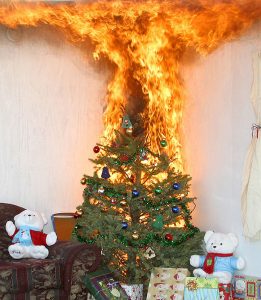 It takes but one weightless spark to incinerate the expected joy of the holidays.
It takes but one weightless spark to incinerate the expected joy of the holidays.
The causes of home fires during December celebrations are often as innocent and miniscule as an unseen fracture in wire cladding of old Christmas tree lights, or a poorly seated Chanukah candle brushed by a happy child wearing a flowing night gown as she races by.
Despite the annual warnings by fire departments across the country to be especially cognizant of fire dangers, inevitably there will be front-page and “News-at-11” stories to report of easily preventable tragedies.
Last year, Newport Beach firefighters extinguished three Christmas tree fires, one of which took off so fast in a peninsula apartment that the young female residents were forced to jump off their balcony to escape.
Newport Beach Fire Department Chief Scott Poster (who retired this week) identified Christmas trees as “the number one problem” in terms of fire threats; but then he modified that by stating, “Maybe the first threat is not having an operating smoke detector. These can save lives.”
So threat number two is dehydrated Christmas trees.
“Keep trees hydrated with water,” Poster said, an admonition supported by the U.S. Fire Administration, who said that Christmas trees “should be watered every day.” According to Poster, trees start to dry out one week after being cut. Although he realizes that it’s unreasonable to think that homeowners will toss their trees after seven days, Poster says, “Trees should be disposed of properly as soon as you can” after Christmas. Disposal does not mean taking it to the beach to watch it burn.
“That’s illegal,” he emphasized. The city offers a recycling pick-up program.
As pretty, celebratory and romantic as candles are, candles come in number three in the causes-of-fires hit parade.
“Candles cannot be left unattended,” Poster underscored. When candles burn down, “they can slide,” he said.
Like an amoeba inexorably inching forward, a burning wick can quickly (or slowly) contact curtains, almost all of which are highly flammable.
“Monitor your candles,” Poster stressed. Experts say keep them at least 12-inches away from anything flammable. The U.S. Fire authority asserts that one-third of all candle fires start in the bedroom – certainly not the kind of heat one wishes for that chamber. December is the peak time of year for home candle fires.
Overloading existing electrical circuits is another cause of home fires, Poster advised. People have a tendency of putting too many wires in the wall plugs, which draw much more than the 15-amp maximum most plugs are designed for. Too many wires leading to too many electrical appliances or decorations in use simultaneously causes heating, ultimately leading to the dreaded and difficult-to-douse electrical fire.
Electrical fires often result in substantially more property damage than other fire types, fire authorities state.
Inarguably, one of the sensate pleasures of the holiday season is the aroma of evergreens wafting through a home. However, Poster recommends artificial, fireproof Christmas trees that can be stored safely throughout the year. He also suggests that LED lights be used, as they produce no perceptible heat and draw relatively little power, thereby obviating the overloading of wall circuits.
The fire department will be “fully staffed and ready” during the holidays, “as we are 24/7/365,” Poster said.
It takes three ingredients working in faultless concert to cause combustion: air, heat and fuel. Newport residents can control this potent trio, thereby guaranteeing that the best holiday heat comes from hot cider, eggnog, and brandy snifters (in moderation, of course).




